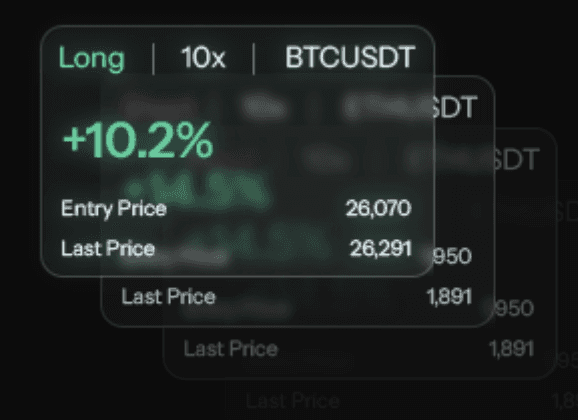/
Trade Entry and Exit Points: How Can You Identify the Best Ones Using Technical Indicators
/
Trade Entry and Exit Points: How Can You Identify the Best Ones Using Technical Indicators
/
Trade Entry and Exit Points: How Can You Identify the Best Ones Using Technical Indicators
Trade Entry and Exit Points: How Can You Identify the Best Ones Using Technical Indicators
Aug 7, 2023
When do you know the right time to either sell or buy? As a trader, you would want to always make the highest predictable profit out of your trades. Buying a crypto asset at a lower price than average gives you an entry point whereas selling a crypto asset at a higher price than average gives you an exit point. In every recurring cycle in the trends, there will be various entry points and exit points which are windows of opportunity to either buy (entry) or sell (exit). But identifying the best entry and exit points is only possible with the needed help of technical indicators.
How to Identify Entry and Exit Points
There is no one method that is right or wrong as you are confronting chaotic markets and market dynamics. Finding the best entry and exit points will immensely increase your profit potential from trades.
Methods and Mechanisms:
Price action analysis: Focusing on the price of an asset and then identify unique patterns.
Candlestick patterns: Doji, harami, and bullish and bearish engulfing patterns.
Continuation and reversal patterns: Bullish and bearish flag, rising and falling wedges, and head and shoulders pattern.
Crossover with two MAs: Monitoring two different sets of moving averages (e.g. 15-day and 50-day).
Trading volume: Seeing how many people are trading in the stock at the moment and making judgment for an entry point.
Any method, technique, or strategy you use in identifying entry and exit points, technical indicators have to be used for near precision and accuracy.
Functionality and Application of Technical Indicators
As a technical indicator is a mathematical calculation based on historic price or volume, we use statistical data to give you the evidence that this is most likely the best time to buy/sell. Technical indicators increase the likelihood that you’re on the right side of market movement and help in determining on asset valuation.
1. Moving Averages (MA, EMA, SMA)
Indicators such as MA, EMA and SMA show a smoothed out line of a coin's price action enabling you to predict critical buy/sell points on the chart. They help identify trends, potential support and resistance levels, and help determine low-risk entries into trades.
2. RSI
RSI aims to measure the speed and size of an asset's price movements. Understanding buy/sell momentum of a coin is important in getting the best timing. Analyzing price change in relation to recent price highs and lows allows you to quickly confirm or change trading strategies.
3. MACD
MACD is a momentum oscillator primarily used to trade trends which measures the relationship between two EMAs. The two primary zones being “overbought” and “oversold”, when reaching such levels, it strongly shows that a new trend has begun.
4. Support/Resistance Levels
Support and resistance levels identify potential price levels where the market may change direction (bounce or reverse). In finding entry zones, support levels are the most commonly referred way.
When demand of an asset is strong enough to prevent the price from declining further, a support level can be identified and is an optimal window to buy. When the supply of an asset is large enough to prevent the price from rising further, a resistance level can be identified and is an optimal window to sell.
5. AO Action
Awesome oscillator is a market momentum and divergence indicator used in confirming a trend and anticipating a potential reversal of the trend. AO can be used to measure both convergence and divergence of an asset’s price.
6. SL and TP
Stop-loss specifies the predetermined price of an asset and take-profit specifies the price to close out a position for profit. Risk management is crucial as a trader. High leverage for instance, can give you a high return attached with a high-risk factor. This is extremely true for cascading liquidations. How do you know your exit strategy at this moment is the safest? SL and TP orders automatically close an open position when a specified trade reaches a certain price level. The two reduces stress as well as balances the amount of risk you individually wish to take.
Conclusion
Regardless of strategy, a combination of different technical indicators are required for best market timing. For example, using the MACD indicator to identify entry and exit signals and confirming these signals with the AO.
Knowing when to effectively buy and sell based on strategic entry and exit points can change your whole gameplay! No matter how bullish or bearish the markets are, there are always opportunities in making a profit. We particularly understand the devastating effects of taking bad exits. That’s why with Market Mapper’s extensive range of technical indicators, you will make robust and sound trading decisions and be able to quickly spot critical moments!

Trade Entry and Exit Points: How Can You Identify the Best Ones Using Technical Indicators
Aug 7, 2023
When do you know the right time to either sell or buy? As a trader, you would want to always make the highest predictable profit out of your trades. Buying a crypto asset at a lower price than average gives you an entry point whereas selling a crypto asset at a higher price than average gives you an exit point. In every recurring cycle in the trends, there will be various entry points and exit points which are windows of opportunity to either buy (entry) or sell (exit). But identifying the best entry and exit points is only possible with the needed help of technical indicators.
How to Identify Entry and Exit Points
There is no one method that is right or wrong as you are confronting chaotic markets and market dynamics. Finding the best entry and exit points will immensely increase your profit potential from trades.
Methods and Mechanisms:
Price action analysis: Focusing on the price of an asset and then identify unique patterns.
Candlestick patterns: Doji, harami, and bullish and bearish engulfing patterns.
Continuation and reversal patterns: Bullish and bearish flag, rising and falling wedges, and head and shoulders pattern.
Crossover with two MAs: Monitoring two different sets of moving averages (e.g. 15-day and 50-day).
Trading volume: Seeing how many people are trading in the stock at the moment and making judgment for an entry point.
Any method, technique, or strategy you use in identifying entry and exit points, technical indicators have to be used for near precision and accuracy.
Functionality and Application of Technical Indicators
As a technical indicator is a mathematical calculation based on historic price or volume, we use statistical data to give you the evidence that this is most likely the best time to buy/sell. Technical indicators increase the likelihood that you’re on the right side of market movement and help in determining on asset valuation.
1. Moving Averages (MA, EMA, SMA)
Indicators such as MA, EMA and SMA show a smoothed out line of a coin's price action enabling you to predict critical buy/sell points on the chart. They help identify trends, potential support and resistance levels, and help determine low-risk entries into trades.
2. RSI
RSI aims to measure the speed and size of an asset's price movements. Understanding buy/sell momentum of a coin is important in getting the best timing. Analyzing price change in relation to recent price highs and lows allows you to quickly confirm or change trading strategies.
3. MACD
MACD is a momentum oscillator primarily used to trade trends which measures the relationship between two EMAs. The two primary zones being “overbought” and “oversold”, when reaching such levels, it strongly shows that a new trend has begun.
4. Support/Resistance Levels
Support and resistance levels identify potential price levels where the market may change direction (bounce or reverse). In finding entry zones, support levels are the most commonly referred way.
When demand of an asset is strong enough to prevent the price from declining further, a support level can be identified and is an optimal window to buy. When the supply of an asset is large enough to prevent the price from rising further, a resistance level can be identified and is an optimal window to sell.
5. AO Action
Awesome oscillator is a market momentum and divergence indicator used in confirming a trend and anticipating a potential reversal of the trend. AO can be used to measure both convergence and divergence of an asset’s price.
6. SL and TP
Stop-loss specifies the predetermined price of an asset and take-profit specifies the price to close out a position for profit. Risk management is crucial as a trader. High leverage for instance, can give you a high return attached with a high-risk factor. This is extremely true for cascading liquidations. How do you know your exit strategy at this moment is the safest? SL and TP orders automatically close an open position when a specified trade reaches a certain price level. The two reduces stress as well as balances the amount of risk you individually wish to take.
Conclusion
Regardless of strategy, a combination of different technical indicators are required for best market timing. For example, using the MACD indicator to identify entry and exit signals and confirming these signals with the AO.
Knowing when to effectively buy and sell based on strategic entry and exit points can change your whole gameplay! No matter how bullish or bearish the markets are, there are always opportunities in making a profit. We particularly understand the devastating effects of taking bad exits. That’s why with Market Mapper’s extensive range of technical indicators, you will make robust and sound trading decisions and be able to quickly spot critical moments!

Trade Entry and Exit Points: How Can You Identify the Best Ones Using Technical Indicators
Aug 7, 2023
When do you know the right time to either sell or buy? As a trader, you would want to always make the highest predictable profit out of your trades. Buying a crypto asset at a lower price than average gives you an entry point whereas selling a crypto asset at a higher price than average gives you an exit point. In every recurring cycle in the trends, there will be various entry points and exit points which are windows of opportunity to either buy (entry) or sell (exit). But identifying the best entry and exit points is only possible with the needed help of technical indicators.
How to Identify Entry and Exit Points
There is no one method that is right or wrong as you are confronting chaotic markets and market dynamics. Finding the best entry and exit points will immensely increase your profit potential from trades.
Methods and Mechanisms:
Price action analysis: Focusing on the price of an asset and then identify unique patterns.
Candlestick patterns: Doji, harami, and bullish and bearish engulfing patterns.
Continuation and reversal patterns: Bullish and bearish flag, rising and falling wedges, and head and shoulders pattern.
Crossover with two MAs: Monitoring two different sets of moving averages (e.g. 15-day and 50-day).
Trading volume: Seeing how many people are trading in the stock at the moment and making judgment for an entry point.
Any method, technique, or strategy you use in identifying entry and exit points, technical indicators have to be used for near precision and accuracy.
Functionality and Application of Technical Indicators
As a technical indicator is a mathematical calculation based on historic price or volume, we use statistical data to give you the evidence that this is most likely the best time to buy/sell. Technical indicators increase the likelihood that you’re on the right side of market movement and help in determining on asset valuation.
1. Moving Averages (MA, EMA, SMA)
Indicators such as MA, EMA and SMA show a smoothed out line of a coin's price action enabling you to predict critical buy/sell points on the chart. They help identify trends, potential support and resistance levels, and help determine low-risk entries into trades.
2. RSI
RSI aims to measure the speed and size of an asset's price movements. Understanding buy/sell momentum of a coin is important in getting the best timing. Analyzing price change in relation to recent price highs and lows allows you to quickly confirm or change trading strategies.
3. MACD
MACD is a momentum oscillator primarily used to trade trends which measures the relationship between two EMAs. The two primary zones being “overbought” and “oversold”, when reaching such levels, it strongly shows that a new trend has begun.
4. Support/Resistance Levels
Support and resistance levels identify potential price levels where the market may change direction (bounce or reverse). In finding entry zones, support levels are the most commonly referred way.
When demand of an asset is strong enough to prevent the price from declining further, a support level can be identified and is an optimal window to buy. When the supply of an asset is large enough to prevent the price from rising further, a resistance level can be identified and is an optimal window to sell.
5. AO Action
Awesome oscillator is a market momentum and divergence indicator used in confirming a trend and anticipating a potential reversal of the trend. AO can be used to measure both convergence and divergence of an asset’s price.
6. SL and TP
Stop-loss specifies the predetermined price of an asset and take-profit specifies the price to close out a position for profit. Risk management is crucial as a trader. High leverage for instance, can give you a high return attached with a high-risk factor. This is extremely true for cascading liquidations. How do you know your exit strategy at this moment is the safest? SL and TP orders automatically close an open position when a specified trade reaches a certain price level. The two reduces stress as well as balances the amount of risk you individually wish to take.
Conclusion
Regardless of strategy, a combination of different technical indicators are required for best market timing. For example, using the MACD indicator to identify entry and exit signals and confirming these signals with the AO.
Knowing when to effectively buy and sell based on strategic entry and exit points can change your whole gameplay! No matter how bullish or bearish the markets are, there are always opportunities in making a profit. We particularly understand the devastating effects of taking bad exits. That’s why with Market Mapper’s extensive range of technical indicators, you will make robust and sound trading decisions and be able to quickly spot critical moments!

Supercharge your trading game with Market Mapper today!




